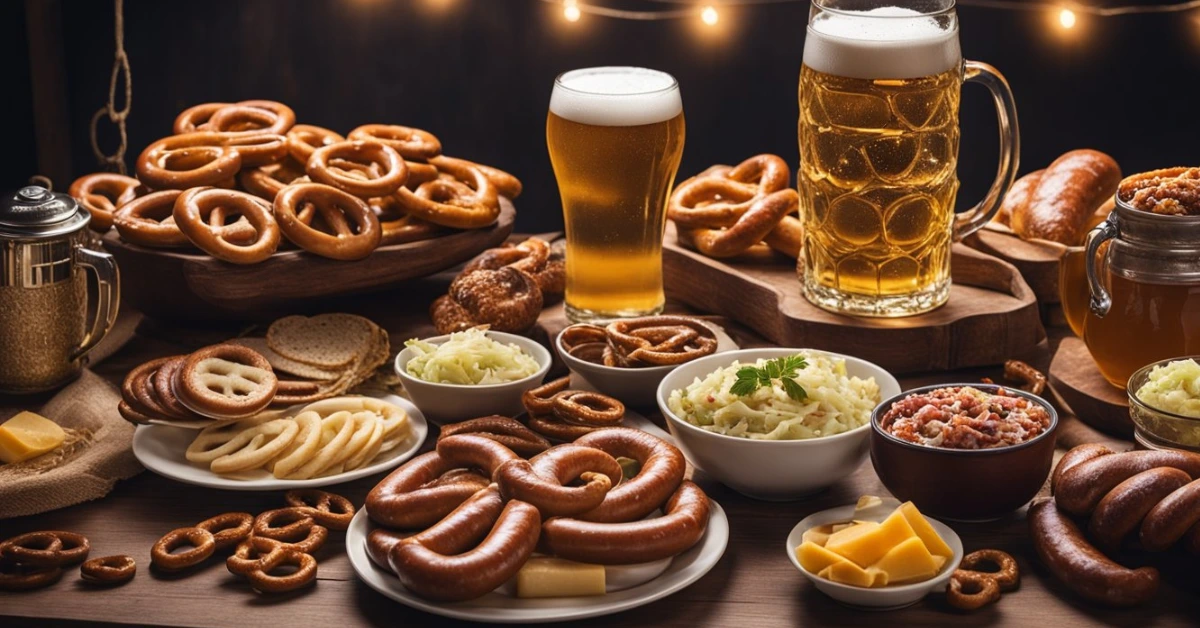If you consider yourself a culinary aficionado, you’ve probably explored a variety of interesting dishes. However, have you delved into the world of unusual German gastronomy? Germany boasts a reputation for its fulfilling meals, characterized by deep, complex flavors and distinctive pairings. Our goal is to guide you through the more obscure, peculiar aspects of Germany’s food culture.
In the world of bizarre gastronomic delights, weird German food surely holds a special place. As you dive into this culinary adventure, you’ll find yourself trying dishes that you’ve never even thought of before. Get ready to challenge your taste buds and expand your culinary horizons. So gather your appetite and let’s explore the fascinating world of weird German food together.
Weird German Food Culture
Have you ever wanted to explore the weird German food scene? Well, you’ve come to the right place! In this article, we dive into the uniqueness of German cuisine, its connection to local cultures, and the importance of regional variations. Let’s get started!
Explanation of the Adventurous Spirit in German Cuisine
Germany is known for its traditional dishes like schnitzel and sausages, but there is more to the country’s culinary repertoire than meets the eye. German chefs aren’t afraid to be adventurous and try some interesting combinations of ingredients, flavors, and textures. This creativity is evident in dishes such as Sülze, a meat jello that can contain veal feet or pork heads.
Connection Between Local Culture and Unique Dishes
German food culture is deeply rooted in the country’s history and regional differences. Each region takes pride in offering unique dishes that showcase local ingredients and traditions. For example, Schwarzsauer, a blood soup popular in northern Germany, is a great example of how local customs influence cuisine. You might not see it on every menu, but those who try it are often pleasantly surprised by its rich flavor.
Importance of Regional Variations
To truly appreciate the weird German food scene, it’s crucial to explore the diverse regional variations that exist throughout the country. Some dishes you might encounter include:
- Spargel: White asparagus from the Baden-Württemberg region, often served with a creamy sauce and potatoes
- Labskaus: A Northern German dish made from corned beef, beetroot, and potatoes, topped with a fried egg
- Stollen: A fruitcake-like bread popular in the Dresden region, filled with marzipan and dried fruits
By experiencing these distinct regional flavors and unique culinary creations, you’ll gain a deeper understanding of Germany’s diverse food culture and an appreciation for the adventurous spirit that drives it. Enjoy your journey through the world of weird German food!
Weisswurst
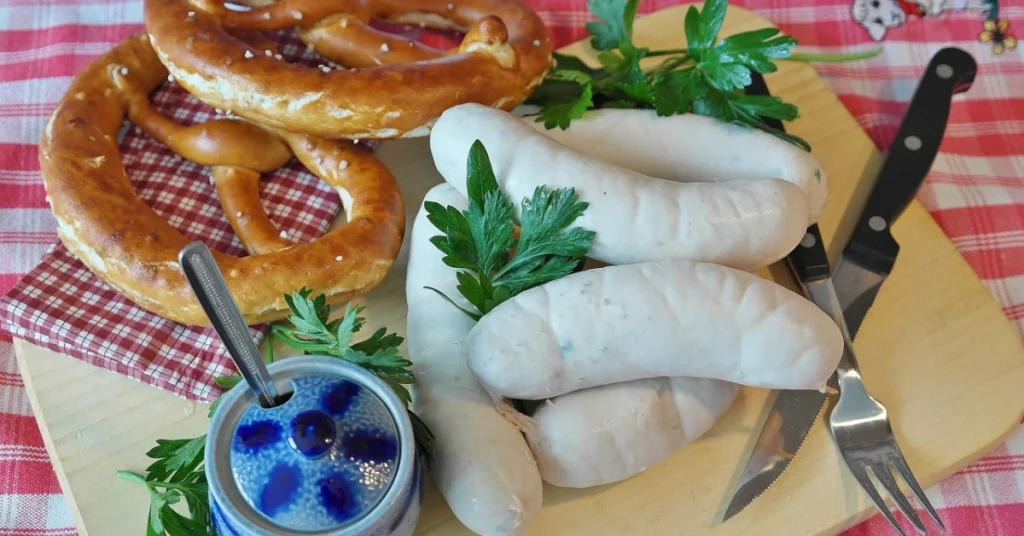
Introduction to Weisswurst (Bavarian White Sausage)
When you think of weird German food, Weisswurst, or Bavarian white sausage, might come to mind. However, despite its unusual appearance, this traditional food from Munich offers a unique and delicious taste that is worth trying.
Historical Background and Cultural Significance
Weisswurst was created in 1857 by a Munich butcher named Sepp Moser, almost by accident. Since then, this delicacy has become an integral part of Bavarian culinary culture. Today, you can find Weisswurst served in various beer gardens, and it is often enjoyed as a traditional morning snack. Here’s a source to learn more about its origins and how you cook your own Weisswurst.
Ingredients and Preparation Process
Typically, Weisswurst consists of minced veal, pork, onions, parsley, bacon, salt, pepper, and a hint of lemon. The mixture is then stuffed into pork casings and seasoned with spices such as nutmeg, ginger, and mace. This website goes into further detail about the exact ingredients and preparation process. It’s important to note that Weisswurst is traditionally served with sweet Bavarian mustard, pretzels, and a glass of Weissbier (Hefeweizen beer) which enhances the overall experience.
Personal Experiences or Anecdotes Related to Trying Weisswurst
Throughout my travels in Germany, I have encountered various local dishes, but trying Weisswurst was definitely a memorable moment. At first, I was hesitant because of its unappealing greyish-white appearance; however, once I took my initial bite, I was pleasantly surprised by its smooth texture and mild, savory flavor. Paired with the sweet mustard and a cold Weissbier, it became a meal I won’t soon forget. So the next time you find yourself in Bavaria, don’t shy away from this tasty yet weird German food – embrace the culinary adventure!
Labskaus
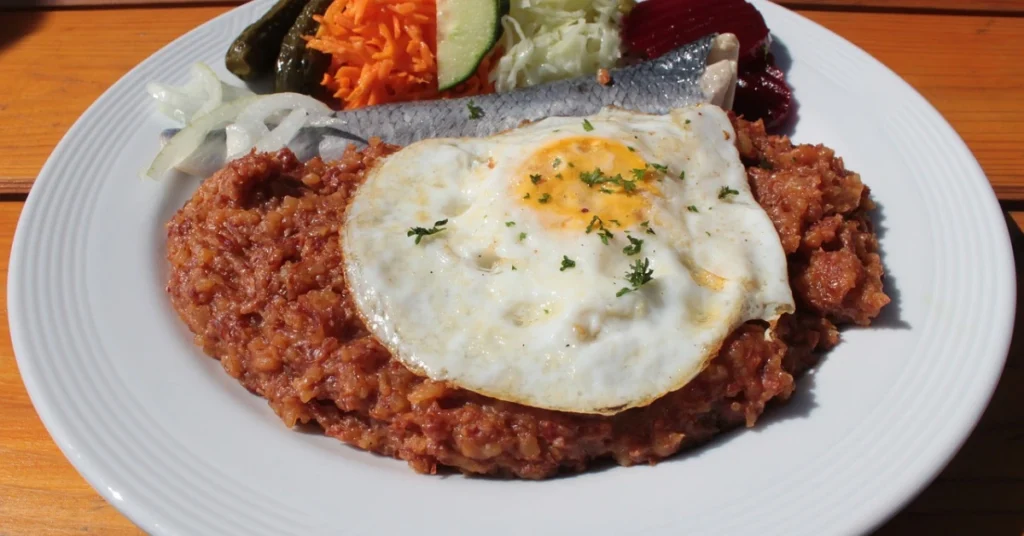
If you’re curious about weird German food, then Labskaus is certainly a dish you should explore! This unique combination of ingredients will intrigue your taste buds and make you want to learn more about its fascinating story.
Overview of Labskaus
Labskaus is a traditional Northern German dish combining a mixture of potatoes, beef, and beets. Though it might seem like an odd mix to some, it is a highly favored meal in the region, particularly in the cities of Bremen, Hamburg, and Lübeck.
Ingredients and Preparation Method
The key components of Labskaus are salted meat or corned beef, potatoes, and onions. Beetroot, pickled gherkin, and even herring are common additions to the dish, while some recipes serve these ingredients as side dishes. A typical Labskaus meal is accompanied by a herring, fried egg, and some pickles1.
To prepare Labskaus:
- Cook corned beef and potatoes separately
- Finely chop the onions and beets
- Mash the potatoes and mix them with corned beef and beets
- Heat the mixture in a pan, adding onions and seasoning to taste
- Serve with a fried egg, pickles, and rollmops (pickled, rolled herring) on the side
Insight into the Dish’s Maritime History
Originally considered a sailor’s staple, Labskaus has a strong connection to the seafaring culture in Northern Germany. The choice of ingredients is largely due to their longevity while at sea. Salted meat and corned beef were easy to preserve, while potatoes and onions could be stored for long periods. The addition of beets and pickles provided essential vitamins to help prevent scurvy.
Modern Variations and Where to Find Labskaus Today
Labskaus used to be seen as a poor person’s food. However, with the rising cost of pickled meats and fish, it has transformed into a luxury dish, often found on the menus of fancy restaurants in Hamburg and other Northern German cities. Some modern variations of Labskaus even come with a twist, such as the addition of different types of fish or other meats.
Exploring the world of weird German food, Labskaus is undoubtedly a dish that provides a flavorful experience combined with an intriguing maritime history. Next time you visit Northern Germany, be sure to give this unique dish a try!
Sülze
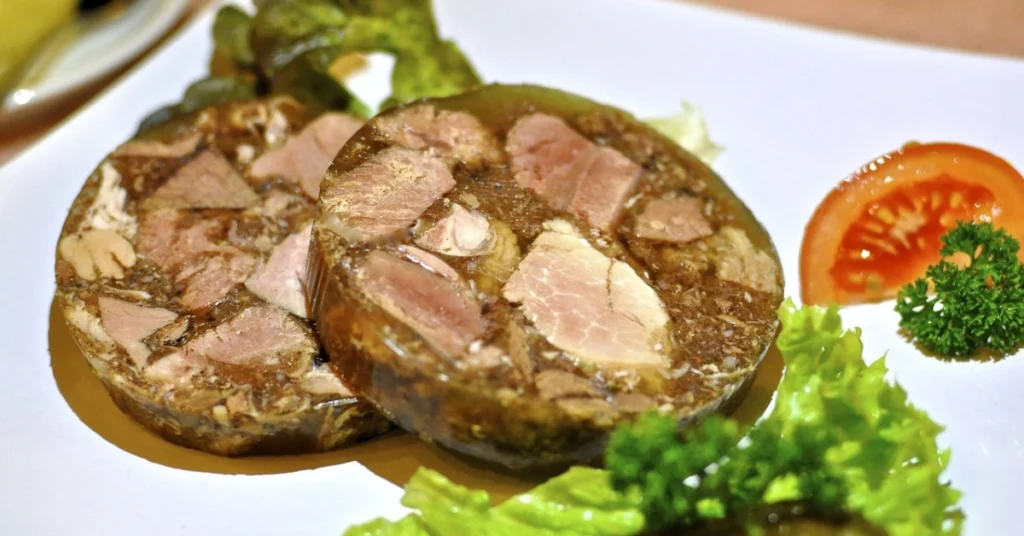
Have you ever been curious about some weird German food? Let’s dive into the fascinating world of Sülze and discover more about its origins, variations, and personal experiences!
Introduction to Sülze
Sülze, also known as Sulz, is a traditional German meat jelly or aspic that is typically made with pork. The process begins by simmering meat – often including collagen-rich parts like pork knuckles, ears, or even tongue – along with vegetables and spices. As it cools, the collagen from the meats creates a natural gelatin, giving it a unique, jelly-like consistency.
Regional Variations and Popular Accompaniments
While Sülze is predominantly found in Germany, it is also popular in Austrian cuisine. There can be slight variations in ingredients and flavors depending on the region. Some versions of Sülze may also incorporate beef or other meats. It’s commonly served cold and sliced, accompanied by various side dishes such as:
- Potatoes
- Bread
- Pickles
- Mustard
This versatile dish can be enjoyed as an appetizer, main course, or even a snack.
Cultural Contexts and Historical Roots
The origins of Sülze can be traced back to medieval Europe, where similar dishes using natural gelatin from meats were common. This unique preparation method was an effective way to preserve meat in the days before refrigeration. Over time, the recipe evolved, and Sülze became a popular dish in German and Austrian cuisine, often enjoyed during festive occasions and communal gatherings.
Personal Impressions or Stories about Tasting Sülze
If you’re new to Sülze, your first encounter with this unusual dish might surprise you. The jelly-like consistency can be a bit of a shock, but once you give it a taste, you’re likely to find it unexpectedly delicious. The savory flavors of the pork and spices are delightful, and the smooth, gelatinous texture creates a unique eating experience. Many people have fond memories of trying Sülze for the first time at a German party or market, bonding with locals over the shared experience of enjoying this distinctive dish. Don’t be afraid to step out of your comfort zone; you might just discover a new favorite!
Mettbrötchen
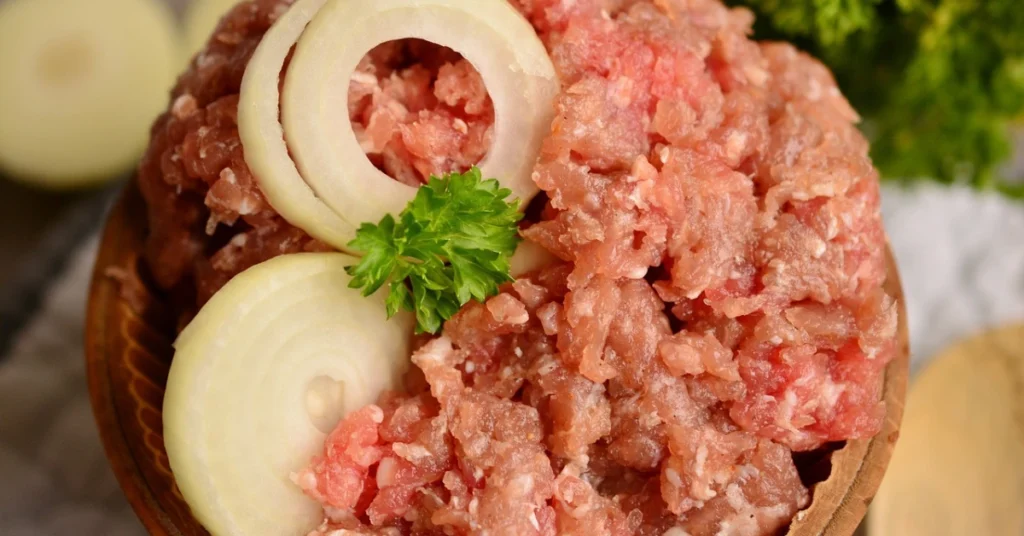
Have you ever come across some weird German food and wondered what it is? Well, let me introduce you to Mettbrötchen, which might be considered unusual to some!
Explanation of Mettbrötchen
Mettbrötchen is a type of sandwich that consists of a fresh brötchen (a German bread roll) and mett (raw pork mince) 1. The bread roll is sliced and then topped with a layer of mett, which is usually seasoned with salt and pepper, and garnished with slices of raw onions on top.
Local Preferences and Variations
There are several regional variations of Mettbrötchen with different names and ingredients. For instance, in northern Germany, it is known as Hackepeter . Zwiebelmett, another variation, includes chopped raw onion, and if onion and rubbed marjoram are added, it is known as Thüringer mett . These local preferences showcase the versatility of this traditional dish. Mettbrötchen is also known as a famous dish for breakfast. Discover here, what are the Top Dishes in Germany for Breakfast.
Cultural Significance and When It’s Commonly Eaten
Mettbrötchen has become a near proverbial love in Germany and is also enjoyed throughout greater parts of Western and Eastern Europe . It is commonly consumed for breakfast or as a quick snack during the day. At social gatherings, you can often find Mettbrötchen as an appetizer or finger food, showcasing its cultural significance in German cuisine.
Tips for Those Trying It for the First Time
If you’re curious about trying Mettbrötchen for the first time, here are some tips to keep in mind:
- Make sure the mett is fresh and of high quality, as it is raw meat. A trusted butcher is your best bet for quality mett.
- Season the mett to your liking with salt, pepper, and other spices, but remember not to overpower the taste of the pork.
- Garnish your Mettbrötchen with thinly sliced onion and perhaps a sprinkle of chopped parsley for extra flavor and texture.
Give Mettbrötchen a try if you’re feeling adventurous and discover a new aspect of German cuisine!
Zungenwurst
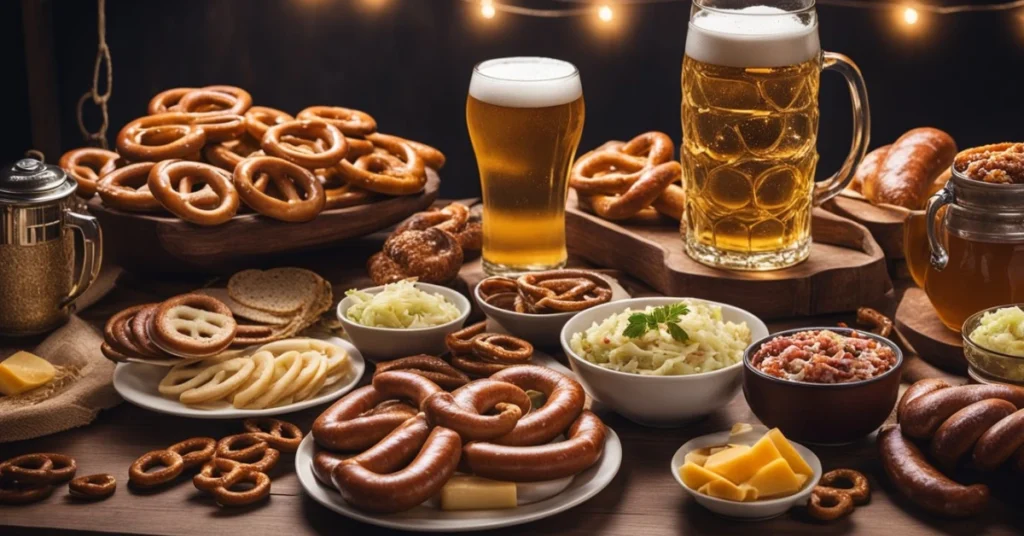
Introduction to Zungenwurst
If you’re fascinated by weird German food, you’ve come to the right place. Meet Zungenwurst, a traditional blood sausage hailing from Germany. In this section, we’ll delve into its cultural background, preparation methods, and the unique taste and texture it offers.
Cultural Background and Traditional Uses
Zungenwurst has been around for quite some time in Germany. This odd delicacy is made from a mixture of pork blood, fat, and pieces of pickled tongues, seasoned with ground pepper and occasionally other strong spices ^1^. Often used in regional recipes, Zungenwurst reflects the resourcefulness of German cuisine, as it uses parts of the animal that might otherwise be discarded. Indeed, this dish is an integral part of the country’s culinary heritage.
Ingredients and Preparation Details
To give you a clearer idea of what goes into making Zungenwurst, here’s a table showing its ingredients:
| Ingredient | Description |
|---|---|
| Pork blood | Gives the sausage its distinct blood flavor and dark color |
| Pork fat | Provides richness and smoothness |
| Pickled tongues | Adds a unique texture and depth of flavor |
| Ground pepper | Seasoning that enhances the overall taste and spice quotient |
The preparation process entails blending the above ingredients to create a homogenous mixture. It’s then stuffed into casings and cooked. The result is a sausage that’s both visually striking and mouthwateringly flavorful.
Reflections on the Taste and Texture
Zungenwurst is popular for its rich, robust taste and distinct texture. The combination of blood, fat, and spices offers deep, satisfying flavors. Additionally, the bites of pickled tongue contribute to an intriguing and characteristic texture. While it might not be everyone’s cup of tea, Zungenwurst is indisputably a fascinating element of German cuisine that captures the culinary imagination of those who taste it.
Grünkohl mit Pinkel

Weird German food has quite a reputation, and Grünkohl mit Pinkel is no exception. In this section, we’ll explore the ins and outs of this unique dish and what makes it a must-try for adventurous foodies like you.
Overview of Grünkohl mit Pinkel
Grünkohl mit Pinkel is a winter comfort food that originates from Northern Germany. It is a remarkable combination of kale and specially made sausage, called Pinkel. The kale, or “Grünkohl,” is finely chopped and cooked with lard and onions, creating a hearty and warming stew-like dish. The Pinkel sausages typically contain pork meat and grits, adding to the distinctive German flavor.
Seasonal Aspects and Popular Times for Consumption
This dish is particularly popular during the colder months of the year, mainly enjoyed between January and February. It is often associated with winter festivities and celebrations. The warmth and richness provided by the kale, lard, and Pinkel sausage make it a perfect meal for combating the chilly Northern German weather.
Ingredients, Preparation, and Serving Traditions
When making Grünkohl mit Pinkel, you’ll find the following ingredients:
- Kale
- Pinkel sausage
- Lard or bacon
- Onions
- Mustard (optional)
Here’s a brief overview of the cooking process for Grünkohl mit Pinkel:
- Clean and chop the kale, removing the thick middle stem.
- Blanch the kale for about 1 minute in boiling water, then drain.
- Brown the lard or bacon in a pan, and sauté the onions with it.
- Add the kale, cook for 2-3 minutes, then add water to cover. Cook until the kale becomes tender.
- In another pan, cook the Pinkel sausages with a little water.
- Serve the kale and Pinkel sausage together, with a side of mustard if desired.
Personal Experiences or Recommendations for Trying It
If you’re intrigued by this weird German food, consider trying Grünkohl mit Pinkel at a traditional German restaurant where you can experience authentic flavors. Alternatively, you can find recipes, such as the one in The Spruce Eats, to prepare and enjoy the dish at home. Remember that Grünkohl mit Pinkel is best enjoyed during the winter months, so plan accordingly and appreciate the unique taste and textures this dish has to offer.
Himmel und Erde
Introduction to Himmel und Erde
Do smells and flavors ever catch you off guard when you bite into a seemingly ordinary dish? You are not alone – some weird German food can do just that. One such dish is Himmel und Erde, which means “Heaven and Earth.” Invented as far back as the 18th century, this traditional German dish combines mashed potatoes and stewed apples, and is sometimes served with sliced blood sausage.
Symbolic Meanings and Cultural Connections
The name Himmel und Erde originates from the old word for potatoes – Erdapfel, which translates to “earth apple.” This dish symbolizes the meeting of heaven (“Himmel”) and earth (“Erde”) through its unique combination of ingredients. It is especially popular in the regions of the Rhineland, Westphalia, Lower Saxony, and Gelderland.
Preparation Details and Variations
For a basic Himmel und Erde, you will need:
- 1 pound starchy potatoes
- 1 pound cooking apples
- 2 tablespoons butter
- Nutmeg, salt, and pepper for seasoning
Boil the potatoes and apples separately, then mash them together. Season the dish with nutmeg, salt, and pepper, adding the butter at the end for a rich, smooth texture. Some recipes add caramelized onions on top, while others serve it with blood sausage or bacon. Since regions across Germany claim to have invented this, there are many variations you might come across.
Personal Stories or Reactions to Tasting Himmel und Erde
Trying Himmel und Erde can be quite the experience, with its surprising mix of sweet and savory flavors. You might be skeptical at first, but this comforting dish can quickly grow on you. The contrast between the potatoes and apples provides a delightful take on the concept of weird German food. Each bite can transport you to a different time when the simple ingredients came together to create a blend of flavors that represented the meeting of heaven and earth.
Schwarzsauer
If you’re looking to explore the world of weird German food, Schwarzsauer is a dish that might pique your interest. This traditional offal soup from Northern Germany has an acquired taste that is definitely worth trying. In this section, we will explore the overview of Schwarzsauer, its historical context, regional variations, ingredients, cooking process, and some suggestions for adventurous eaters willing to give it a shot.
Overview of Schwarzsauer
Schwarzsauer is a traditional North German dish often associated with the region of Schleswig-Holstein. This blood soup has unique flavors, thanks to the various spices cooked in vinegar-water, earning its place as a notable dish in German cuisine. The soup is a type of black pudding made with vinegar, making it quite similar to the ancient Spartan black soup.
Historical Context and Regional Variations
The origins of Schwarzsauer can be traced back to the northern parts of Germany where it was mainly prepared during pig slaughter. Fresh blood was collected and cooked along with pork, vinegar, onions, root vegetables, and spices such as bay leaves and peppercorns. While Schwarzsauer is most commonly associated with the Schleswig-Holstein region, similar dishes are also found in East Prussia and other North German areas.
Ingredients and Cooking Process
The main ingredients of Schwarzsauer include goose or pork giblets, blood, vinegar, and peppercorns. Some variations also incorporate root vegetables and other spices to suit regional tastes. The giblets and blood are cooked with vinegar and spices, creating the soup base. The soup is then carefully heated and stirred until partly cooked, resulting in a thick, rich texture.
Suggestions for the Adventurous Eater Willing to Try It
If you’re eager to experience this unique, weird German food, consider enjoying Schwarzsauer with traditional side dishes such as boiled potatoes or flour dumplings. Keep an open mind and allow your palate to explore the unusual flavors of this dish, and remember that it is a part of Germany’s rich culinary heritage.
Our Opinion about weird German food
Okay, admittedly, there really is some weird German food. Sometimes it’s because of the strange combination of ingredients, sometimes it’s because the consistency of the dishes takes some getting used to.
But I can promise you one thing. They are all delicious and it’s worth trying them. And who knows, maybe one or two weird German food examples will find their way into your recipe book.
1. What is the weirdest German food?
The weirdest German food is probably “Schlachtplatte,” a dish made with various types of meat and sausages. It’s getting more weird if you translate this Name directly into English. Check it out!
What is the most popular German street food?
Currywurst is the most popular German street food, consisting of steamed, then fried pork sausage, seasoned with curry ketchup. This food is found all over Germany and so it’s widely known.
What are some unusual German food combinations?
Some unusual and weird German food combinations include “Himmel und Erde” (heaven and earth), a dish made with mashed potatoes, apples, and blood sausage.
What do you think is the weirdest German foot, that tried so far? Let us know in the commentary or reach out to us.

